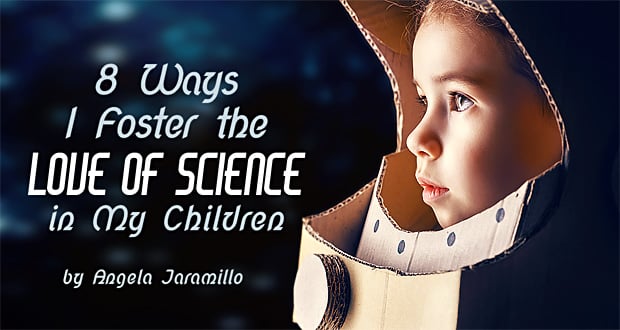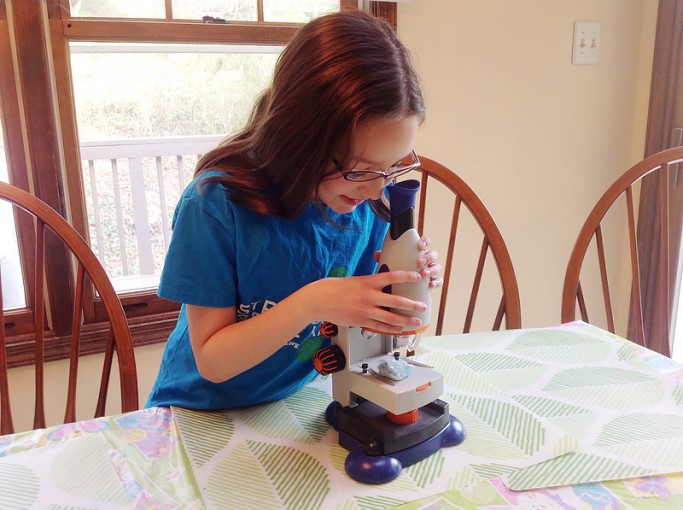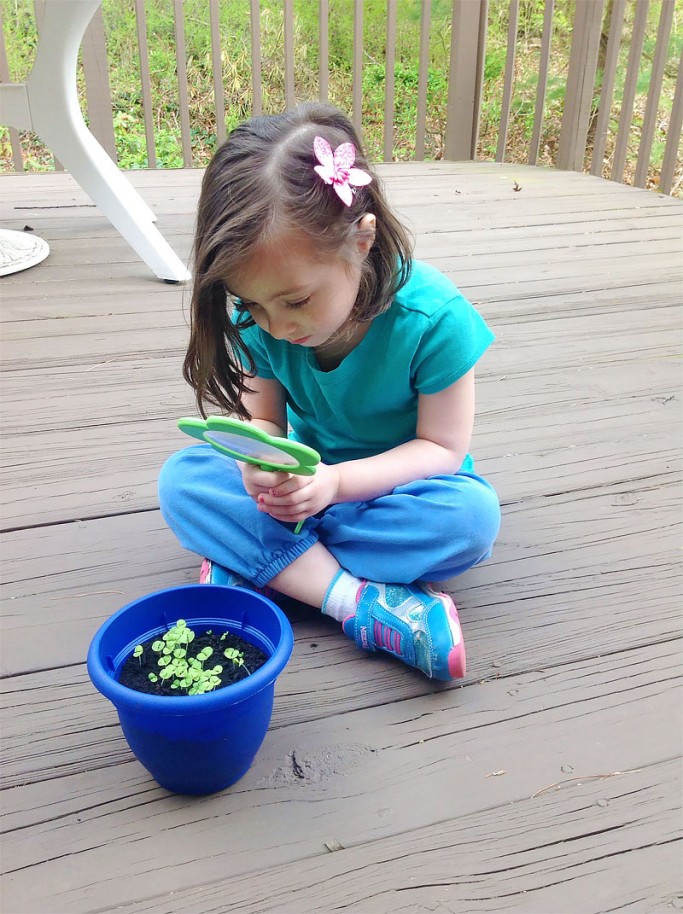Editor's note: This article originally appeared in Seton Magazine and is reprinted with permission by Seton Home Study School. We thank them for their sponsorship of CatholicMom.com this month. --Lisa
“Mom, how many feet do you think a manta ray can jump out of water?” my nine-year-old daughter asks. “Hmmm, maybe three feet,” I respond. “Nope, 7 feet!” Excitedly she teaches me and then buries her nose back into her book. How did we foster this love of science?
Not too long ago, I would have naively told you that I really thought all kids were reading and doing science independently for fun, until I recently went to a birthday party. The mom of the three-year-old birthday girl had asked me to buy her some science books. I happily fulfilled that request, purchasing some age-appropriate books on bugs and ocean animals.
When her daughter opened the gifts, she smiled as much as a big kid toddler could, while her mom gave me the thumbs up. However, an onlooker, a twelve-year-old boy, very much disapproved and grumbled that the little girl wouldn’t touch science until the 8th grade, and that was the worst gift ever!
Wow! I quickly learned that there must have been many subtle and not-so-subtle ways I had been fostering the love of science in my kids.
Before I became a stay at home mom, I was a research scientist at a pharmaceutical company. Every day at work, through God’s grace, I experienced a healthy dosage of awe and wonder. Scientists will all tell you the more we discover, the more we realize how little we really know. It’s quite the blessing and quite humbling.
My parents weren’t scientists and didn’t finish college, but what they gave me was greater than anything learned in a book. They surrounded me with nature and a love for God. Plus, they gave me a microscope and chemistry set when I was quite young. That didn’t hurt either!
Here I share some of the things this science-loving mom does with her kids to foster the love of science:
1. A nature wagon.
We fill one of those small kiddie wagons with magnifying glasses, bug catchers, notebooks, rulers, gloves, binoculars, etc. and go for nature walks around our home.
We create a base camp and start our nature explorations. Mind you, we live in the suburbs of Philadelphia, so the nature around us is quite tame except for the squirrels!
2. A microscope.
We have a microscope handy at all times. My kids have placed rocks, acorns and other much too gross to mention things under their scope! It really allows them to appreciate the small details that escape their eyes.
3. Colorful science books to look through.
Notice I didn’t say read the books. We comment on the colorful pictures. My three-year-old can’t get enough of looking at a praying mantis. Our little home library is brimming with books (not textbooks) on bugs, ocean animals, rocks, space, dinosaurs, the human body, etc. Our library card is quite worn out, too.
The local library’s science section is amazing, and when we’re lucky we can purchase some used books for just fifty cents!
4. Chemistry.
I haven’t purchased a real chemistry kit yet, but instead I let my nine year old take the lead on concocting reactions in the kitchen. We take a giant pot and pour in all types of items (colored sugar crystals, food dye, BBQ sauce) that will make the color, density and visibility of the liquid change.
It can get messy, but sometimes I get really tempted to try it because it smells like a yummy soup!
5. Trips to arboretums.
We have a couple of arboretums by our home, and they have the most amazing tree houses you can imagine. Of course trips to the science museum, zoo and aquarium inspire budding scientists. The concern I hear the most from families is cost. Find an arboretum near you.
But, let me tell you… coupons, coupons and more coupons! Many online discount sites offer great deals. I’ve given up paying full price for any attraction.
6. Having a plant and a rock garden.
I do not have much of a green thumb and so to get pumped up for another attempt of gardening, we go to our local organic farm. Ours has a large, open dirt pit with tons of shovels and spades for little ones to pretend to farm and get all dirty. Those kids do not want to leave!
The wheels in my kids’ minds are visibly churning as they pick their own blackberries and connect where food really comes from. For those of us who are not meant to become botanists, rock gardens are fun for the kids to make. We don’t go buy pretty rocks; we just add whatever we see around us. Geodes are always pleasant surprises.
7. Fish and snails.
We can’t have cats or dogs because of allergies, but we do have fish and snails. That has fostered a fascination with fresh water and marine biology. One of our fish tanks happened to be a self-cleaning eco-tank in which edible plants filtered the water.
You harvest and reseed the plants to eat, such as herbs. That took a lot of work for the kids to manage (so it didn’t last long with little ones), but it was a great home lesson on ecosystems.
8. Free summer science classes.
Our local library, in collaboration with certain foundations, offers free science classes in the summer. Last year, it was on chemistry. They all received adorable goggles and Erlenmeyer flasks. These free classes can be found also in state parks, watersheds, conservatories, etc. You just need to register ahead of time.
My kids are on the younger side, but as they grow I have tons of ideas to continue our journey enjoying science and nature. In the future, I plan to get a telescope and a DNA kit. The ideas are limitless. Where there is wonder, there is a way!
Oh and by the way, don’t worry! I didn’t let the twelve-year-old boy off the hook for the anti-science remarks. Later that day, we had a nice discussion of what science he did enjoy, which did take quite a bit of pulling out of him. At the end, he smiled and said yes he loves engineering!
Copyright 2015 Angela Maria Jaramillo.
Images copyright 2015 Angela Maria Jaramillo. All rights reserved.
Reprinted with permission from Seton Magazine.
 Angela Maria Jaramillo is a stay at home mom of three young children. She’s a cradle Catholic who loves watching those kiddie Catholic cartoons. After her third child, she decided to hang up her lab coat as a research scientist and focus her full attention onto her family. She uses her PhD in Neuroscience from the University of Pennsylvania and her training as a fellow from Princeton University to foster the love of science in her children.
Angela Maria Jaramillo is a stay at home mom of three young children. She’s a cradle Catholic who loves watching those kiddie Catholic cartoons. After her third child, she decided to hang up her lab coat as a research scientist and focus her full attention onto her family. She uses her PhD in Neuroscience from the University of Pennsylvania and her training as a fellow from Princeton University to foster the love of science in her children.
About the Author

Guest
We welcome guest contributors who graciously volunteer their writing for our readers. Please support our guest writers by visiting their sites, purchasing their work, and leaving comments to thank them for sharing their gifts here on CatholicMom.com. To inquire about serving as a guest contributor, contact editor@CatholicMom.com.





.png?width=1806&height=731&name=CatholicMom_hcfm_logo1_pos_871c_2728c%20(002).png)
Comments